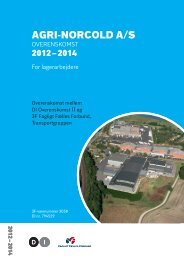Hydrogen and its competitors, 2004
Hydrogen and its competitors, 2004
Hydrogen and its competitors, 2004
Create successful ePaper yourself
Turn your PDF publications into a flip-book with our unique Google optimized e-Paper software.
28Risø Energy Report 3Technologies for producing hydrogen5.1BiomassH 2 CO 2AgriculturalproductsPretreatmentGasseparationOrganicwasteFermentation(Metabolicallyengineeredorganisms)Figure 7: <strong>Hydrogen</strong> production based on fermentation [13].enzymes used have high energy dem<strong>and</strong>s, solar energyconversion efficiencies are low, <strong>and</strong> huge areas of photobioreactorsare needed [13].It is often argued that it is simpler <strong>and</strong> more efficient toextract the hydrogen from organic substrates using adark fermentation process.Dark fermentation under aerobic conditions usesbiomass such as plant materials <strong>and</strong> organic wastestreams (Figure 7). Most of the hydrogen is actuallyproduced during anaerobic metabolism of pyruvateformed during the catabolism of carbohydrates <strong>and</strong>other substrates. There is scope for metabolic engineeringof the micro-organisms to redirect electrons so asto increase the hydrogen yields [13].Thermochemical conversionBiomass consists of carbon, hydrogen, oxygen, <strong>and</strong>nutrients such as nitrogen <strong>and</strong> sulphur. Figure 8compares the composition of wood with that of hydrocarbonfuels. Wood consists mainly of cellulose, whichcontains 6.2% hydrogen. As a result, the total hydrogencontent of wood is close to 6% <strong>and</strong> biomass is a reasonablefeed for hydrogen production.A large number of thermochemical processes to producehydrogen from biomass are under development ([11,14];see also other references to reviews of processes <strong>and</strong>experimental technologies).In thermal gasification, solid biomass is first convertedthermochemically into a gas. In the case of steam gasification<strong>and</strong> other indirectly-heated gasification processes,the result is a synthesis gas which can then be convertedto hydrogen.The first step in gasification is pyrolysis, in which thedissociated <strong>and</strong> volatile components of the biomass (70-85% of the dry weight) are vaporised at temperatures oftypically around 600°C. The resulting gas, whichcontains H 2 , CO, CO 2 , tar <strong>and</strong> water vapour, is firstcleaned to remove impurities <strong>and</strong> then optionallyupgraded using the water gas shift reaction to yield CO 2<strong>and</strong> hydrogen. The final step is to purify the hydrogen.The residue from pyrolysis is a mixture of char (fixedcarbon) <strong>and</strong> ash. The char is subsequently gasified byreacting it with oxygen, steam <strong>and</strong>/or hydrogen, <strong>and</strong> thisprovides the heat needed to run the gasifier.Many gasification systems have been developed [11].Among the more unusual of these are the use of solarenergy to provide the heat for gasification [15] <strong>and</strong> theaqueous conversion of biomass to hydrogen undersupercritical conditions (374°C <strong>and</strong> 22 MPa) [16].Fast pyrolysis processes can convert biomass into twooxygenated oils. These can be stored as intermediates,<strong>and</strong> later steam reformed to yield hydrogen <strong>and</strong> CO.Biomass-derived methanol <strong>and</strong> ethanol may also besteam reformed in the presence of a catalyst to producehydrogen. Methane derived from anaerobic digestioncan yield hydrogen through pyrolysis as well asreforming [11].Research needsTechnologies must be developed <strong>and</strong> sized according tothe availability <strong>and</strong> quality of locally-available biomass.Biomass is assessed in terms of price (including transportcosts), distribution, mass, <strong>and</strong> physical <strong>and</strong> chemicalproperties. Future research should also assess whetherthermochemical <strong>and</strong> biological processes could becombined. Biological processes are in general less energyintensive<strong>and</strong> more environment-friendly than thermochemicalprocesses.Biological routes• Development of crops with compositions optimised forbiological hydrogen production.
















